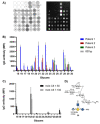Semi-Synthetic Glycoconjugate Vaccine Lead Against Acinetobacter baumannii 17978
- PMID: 35950629
- PMCID: PMC9826233
- DOI: 10.1002/anie.202209556
Semi-Synthetic Glycoconjugate Vaccine Lead Against Acinetobacter baumannii 17978
Abstract
Acinetobacter baumannii is a opportunistic bacterial pathogen responsible for serious nosocomial infections that is becoming increasingly resistant against antibiotics. Capsular polysaccharides (CPS) that cover A. baumannii are a major virulence factor that play an important role in pathogenesis, are used to assign serotypes and provide the basis for vaccine development. Synthetic oligosaccharides resembling the CPS of A. baumannii 17978 were printed onto microarray slides and used to screen sera from patients infected with A. baumannii as well as a monoclonal mouse antibody (mAb C8). A synthetic oligosaccharide emerged from glycan array screening as lead for the development of a vaccine against A. baumannii 17978. Tetrasaccharide 20 is a key epitope for recognition by an antibody and is a vaccine lead.
Keywords: Acinetobacter Baumannii; Carbohydrate; Glycans; Immunology; Total Synthesis.
© 2022 The Authors. Angewandte Chemie International Edition published by Wiley-VCH GmbH.
Conflict of interest statement
The authors declare no conflict of interest.
Figures






Similar articles
-
Discovery of Oligosaccharide Antigens for Semi-Synthetic Glycoconjugate Vaccine Leads against Streptococcus suis Serotypes 2, 3, 9 and 14*.Angew Chem Int Ed Engl. 2021 Jun 21;60(26):14679-14692. doi: 10.1002/anie.202103990. Epub 2021 May 19. Angew Chem Int Ed Engl. 2021. PMID: 33852172 Free PMC article.
-
Immune Response to Conjugates of Fragments of the Type K9 Capsular Polysaccharide of Acinetobacter baumannii with Carrier Proteins.Microbiol Spectr. 2022 Oct 26;10(5):e0167422. doi: 10.1128/spectrum.01674-22. Epub 2022 Aug 18. Microbiol Spectr. 2022. PMID: 35980044 Free PMC article.
-
Delineating the Plausible Molecular Vaccine Candidates and Drug Targets of Multidrug-Resistant Acinetobacter baumannii.Front Cell Infect Microbiol. 2019 Jun 20;9:203. doi: 10.3389/fcimb.2019.00203. eCollection 2019. Front Cell Infect Microbiol. 2019. PMID: 31281799 Free PMC article.
-
Biology of Acinetobacter baumannii: Pathogenesis, Antibiotic Resistance Mechanisms, and Prospective Treatment Options.Front Cell Infect Microbiol. 2017 Mar 13;7:55. doi: 10.3389/fcimb.2017.00055. eCollection 2017. Front Cell Infect Microbiol. 2017. PMID: 28348979 Free PMC article. Review.
-
Where are we and how far is there to go in the development of an Acinetobacter vaccine?Expert Rev Vaccines. 2021 Mar;20(3):281-295. doi: 10.1080/14760584.2021.1887735. Epub 2021 Feb 20. Expert Rev Vaccines. 2021. PMID: 33554671 Review.
Cited by
-
A novel mRNA multi-epitope vaccine of Acinetobacter baumannii based on multi-target protein design in immunoinformatic approach.BMC Genomics. 2024 Aug 19;25(1):791. doi: 10.1186/s12864-024-10691-7. BMC Genomics. 2024. PMID: 39160492 Free PMC article.
-
A Hitchhiker's Guide to Problem Selection in Carbohydrate Synthesis.ACS Cent Sci. 2023 Jul 12;9(7):1285-1296. doi: 10.1021/acscentsci.3c00507. eCollection 2023 Jul 26. ACS Cent Sci. 2023. PMID: 37521800 Free PMC article. Review.
-
Non-antibiotic prevention and treatment against Acinetobacter baumannii infection: Are vaccines and adjuvants effective strategies?Front Microbiol. 2023 Jan 25;14:1049917. doi: 10.3389/fmicb.2023.1049917. eCollection 2023. Front Microbiol. 2023. PMID: 36760499 Free PMC article. Review.
-
Development in the Concept of Bacterial Polysaccharide Repeating Unit-Based Antibacterial Conjugate Vaccines.ACS Infect Dis. 2023 Feb 10;9(2):178-212. doi: 10.1021/acsinfecdis.2c00559. Epub 2023 Jan 27. ACS Infect Dis. 2023. PMID: 36706246 Free PMC article. Review.
-
Chemical Synthesis and Antigenic Evaluation of Oligosaccharides of Bordetella hinzii O-Antigen Containing Unique Amidated 2,3-Diacetamido-2,3-dideoxy-alduronic Acids.JACS Au. 2025 Apr 16;5(4):1903-1913. doi: 10.1021/jacsau.5c00113. eCollection 2025 Apr 28. JACS Au. 2025. PMID: 40313848 Free PMC article.
References
-
- Gordon N. C., Wareham D. W., Int. J. Antimicrob. Agents 2010, 35, 219–226. - PubMed
-
- Lees-Miller R. G., Iwashkiw J. A., Scott N. E., Seper A., Vinogradov E., Schild S., Feldman M. F., Mol. Microbiol. 2013, 89, 816–830. - PubMed
-
- None
-
- CDC, Antibiotic Resistance Threats in the United State. 2019, 64–68. https://www.cdc.gov/drugresistance/pdf/threats-report/2019-ar-threats-re...;
-
- HHS Food and Drug Administration, Fed Regist. 2014, 79, 32464–32481; - PubMed
Publication types
MeSH terms
Substances
LinkOut - more resources
Full Text Sources
Molecular Biology Databases

